check engine light Alfa Romeo 4C 2016 Owner handbook (in English)
[x] Cancel search | Manufacturer: ALFA ROMEO, Model Year: 2016, Model line: 4C, Model: Alfa Romeo 4C 2016Pages: 182, PDF Size: 9.49 MB
Page 104 of 182
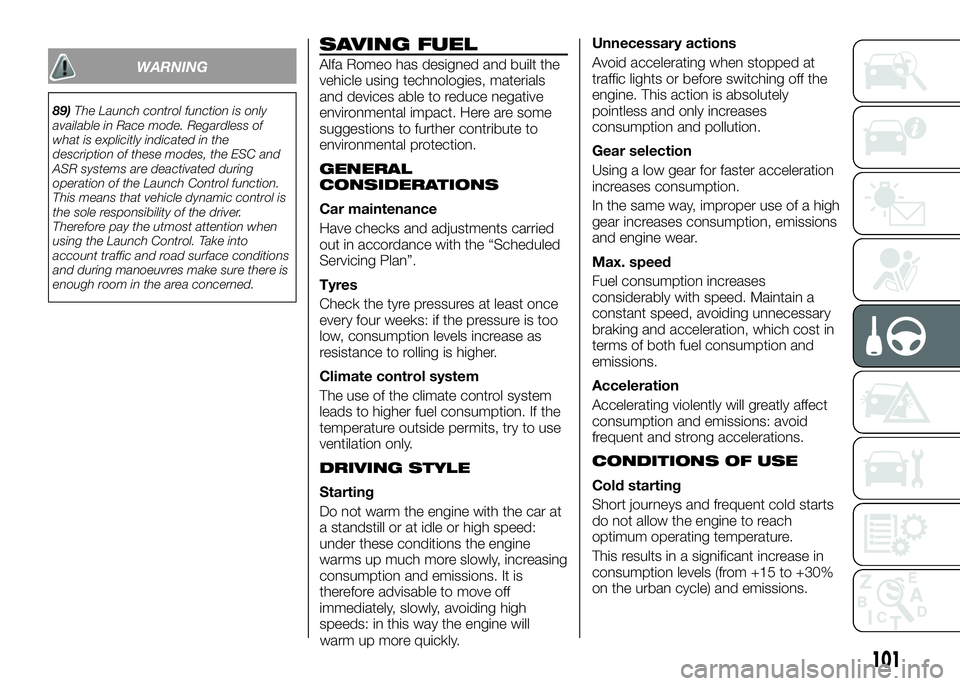
WARNING
89)The Launch control function is only
available in Race mode. Regardless of
what is explicitly indicated in the
description of these modes, the ESC and
ASR systems are deactivated during
operation of the Launch Control function.
This means that vehicle dynamic control is
the sole responsibility of the driver.
Therefore pay the utmost attention when
using the Launch Control. Take into
account traffic and road surface conditions
and during manoeuvres make sure there is
enough room in the area concerned.
SAVING FUEL
Alfa Romeo has designed and built the
vehicle using technologies, materials
and devices able to reduce negative
environmental impact. Here are some
suggestions to further contribute to
environmental protection.
GENERAL
CONSIDERATIONS
Car maintenance
Have checks and adjustments carried
out in accordance with the “Scheduled
Servicing Plan”.
Tyres
Check the tyre pressures at least once
every four weeks: if the pressure is too
low, consumption levels increase as
resistance to rolling is higher.
Climate control system
The use of the climate control system
leads to higher fuel consumption. If the
temperature outside permits, try to use
ventilation only.
DRIVING STYLE
Starting
Do not warm the engine with the car at
a standstill or at idle or high speed:
under these conditions the engine
warms up much more slowly, increasing
consumption and emissions. It is
therefore advisable to move off
immediately, slowly, avoiding high
speeds: in this way the engine will
warm up more quickly.Unnecessary actions
Avoid accelerating when stopped at
traffic lights or before switching off the
engine. This action is absolutely
pointless and only increases
consumption and pollution.
Gear selection
Using a low gear for faster acceleration
increases consumption.
In the same way, improper use of a high
gear increases consumption, emissions
and engine wear.
Max. speed
Fuel consumption increases
considerably with speed. Maintain a
constant speed, avoiding unnecessary
braking and acceleration, which cost in
terms of both fuel consumption and
emissions.
Acceleration
Accelerating violently will greatly affect
consumption and emissions: avoid
frequent and strong accelerations.
CONDITIONS OF USE
Cold starting
Short journeys and frequent cold starts
do not allow the engine to reach
optimum operating temperature.
This results in a significant increase in
consumption levels (from +15 to +30%
on the urban cycle) and emissions.
101
Page 106 of 182
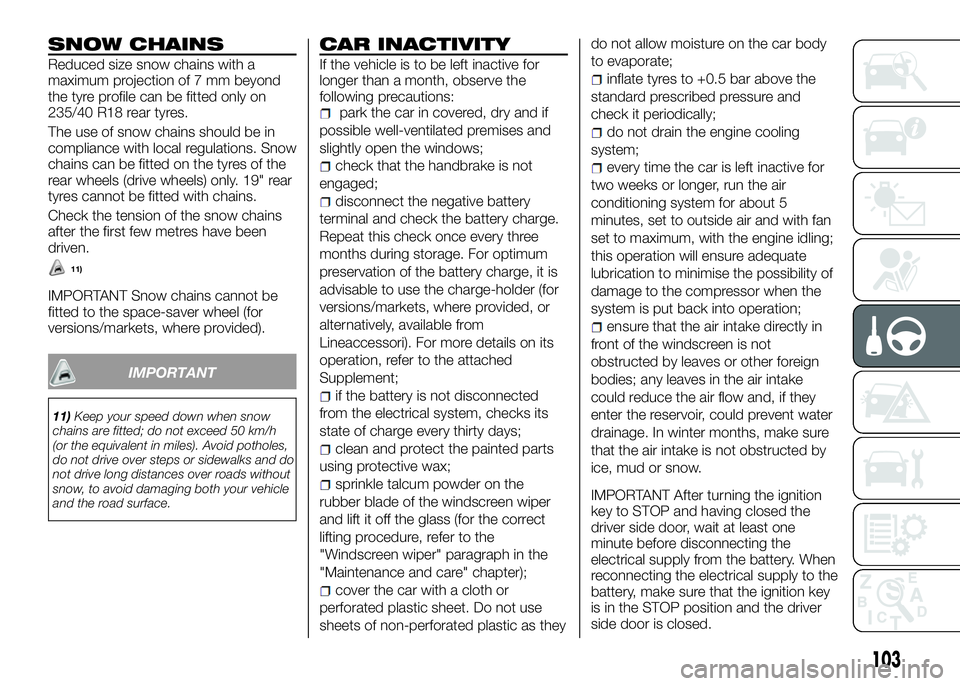
SNOW CHAINS
Reduced size snow chains with a
maximum projection of 7 mm beyond
the tyre profile can be fitted only on
235/40 R18 rear tyres.
The use of snow chains should be in
compliance with local regulations. Snow
chains can be fitted on the tyres of the
rear wheels (drive wheels) only. 19" rear
tyres cannot be fitted with chains.
Check the tension of the snow chains
after the first few metres have been
driven.
11)
IMPORTANT Snow chains cannot be
fitted to the space-saver wheel (for
versions/markets, where provided).
IMPORTANT
11)Keep your speed down when snow
chains are fitted; do not exceed 50 km/h
(or the equivalent in miles). Avoid potholes,
do not drive over steps or sidewalks and do
not drive long distances over roads without
snow, to avoid damaging both your vehicle
and the road surface.
CAR INACTIVITY
If the vehicle is to be left inactive for
longer than a month, observe the
following precautions:
park the car in covered, dry and if
possible well-ventilated premises and
slightly open the windows;
check that the handbrake is not
engaged;
disconnect the negative battery
terminal and check the battery charge.
Repeat this check once every three
months during storage. For optimum
preservation of the battery charge, it is
advisable to use the charge-holder (for
versions/markets, where provided, or
alternatively, available from
Lineaccessori). For more details on its
operation, refer to the attached
Supplement;
if the battery is not disconnected
from the electrical system, checks its
state of charge every thirty days;
clean and protect the painted parts
using protective wax;
sprinkle talcum powder on the
rubber blade of the windscreen wiper
and lift it off the glass (for the correct
lifting procedure, refer to the
"Windscreen wiper" paragraph in the
"Maintenance and care" chapter);
cover the car with a cloth or
perforated plastic sheet. Do not use
sheets of non-perforated plastic as theydo not allow moisture on the car body
to evaporate;
inflate tyres to +0.5 bar above the
standard prescribed pressure and
check it periodically;
do not drain the engine cooling
system;
every time the car is left inactive for
two weeks or longer, run the air
conditioning system for about 5
minutes, set to outside air and with fan
set to maximum, with the engine idling;
this operation will ensure adequate
lubrication to minimise the possibility of
damage to the compressor when the
system is put back into operation;
ensure that the air intake directly in
front of the windscreen is not
obstructed by leaves or other foreign
bodies; any leaves in the air intake
could reduce the air flow and, if they
enter the reservoir, could prevent water
drainage. In winter months, make sure
that the air intake is not obstructed by
ice, mud or snow.
IMPORTANT After turning the ignition
key to STOP and having closed the
driver side door, wait at least one
minute before disconnecting the
electrical supply from the battery. When
reconnecting the electrical supply to the
battery, make sure that the ignition key
is in the STOP position and the driver
side door is closed.
103
Page 108 of 182
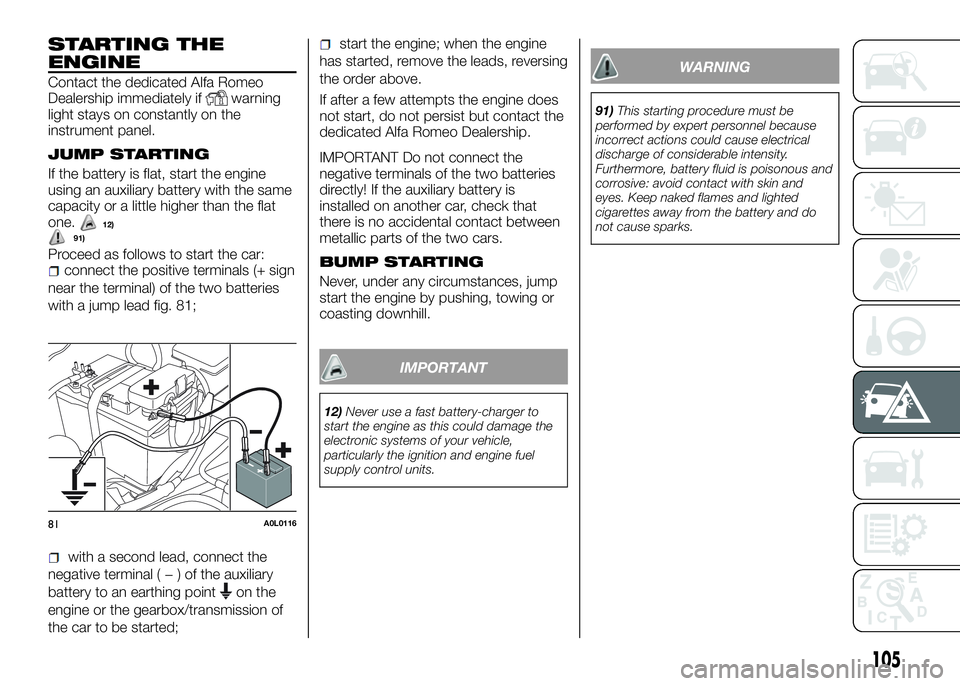
STARTING THE
ENGINE
Contact the dedicated Alfa Romeo
Dealership immediately ifwarning
light stays on constantly on the
instrument panel.
JUMP STARTING
If the battery is flat, start the engine
using an auxiliary battery with the same
capacity or a little higher than the flat
one.
Proceed as follows to start the car:connect the positive terminals (+ sign
near the terminal) of the two batteries
with a jump lead fig. 81;
with a second lead, connect the
negative terminal(−)oftheauxiliary
battery to an earthing point
on the
engine or the gearbox/transmission of
the car to be started;
start the engine; when the engine
has started, remove the leads, reversing
the order above.
If after a few attempts the engine does
not start, do not persist but contact the
dedicated Alfa Romeo Dealership.
IMPORTANT Do not connect the
negative terminals of the two batteries
directly! If the auxiliary battery is
installed on another car, check that
there is no accidental contact between
metallic parts of the two cars.
BUMP STARTING
Never, under any circumstances, jump
start the engine by pushing, towing or
coasting downhill.
IMPORTANT
12)Never use a fast battery-charger to
start the engine as this could damage the
electronic systems of your vehicle,
particularly the ignition and engine fuel
supply control units.
WARNING
91)This starting procedure must be
performed by expert personnel because
incorrect actions could cause electrical
discharge of considerable intensity.
Furthermore, battery fluid is poisonous and
corrosive: avoid contact with skin and
eyes. Keep naked flames and lighted
cigarettes away from the battery and do
not cause sparks.
81A0L0116
105
91)12)
Page 115 of 182
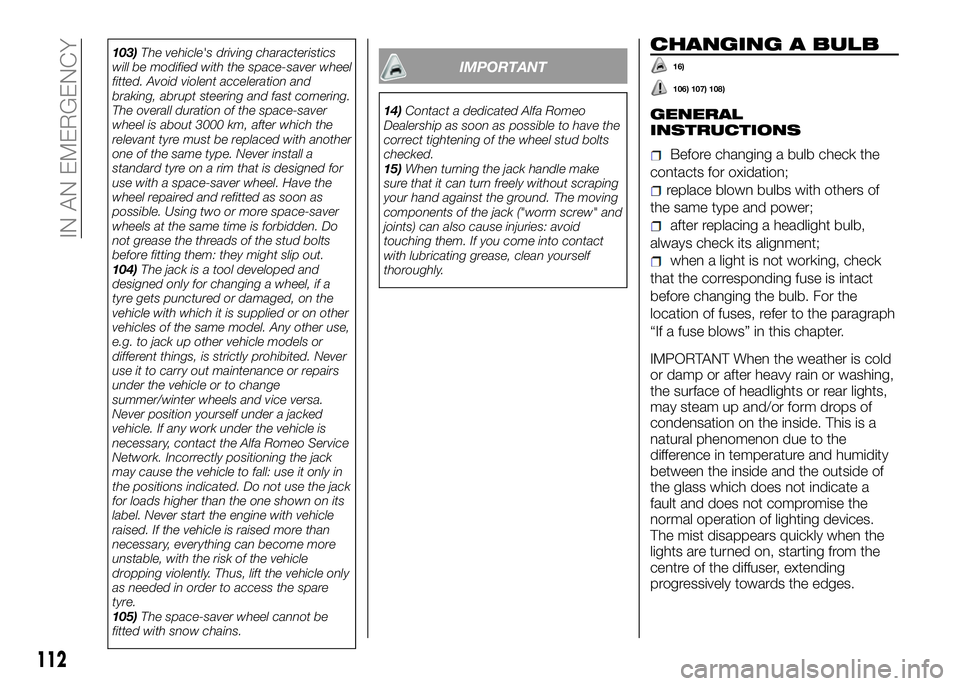
103)The vehicle's driving characteristics
will be modified with the space-saver wheel
fitted. Avoid violent acceleration and
braking, abrupt steering and fast cornering.
The overall duration of the space-saver
wheel is about 3000 km, after which the
relevant tyre must be replaced with another
one of the same type. Never install a
standard tyre on a rim that is designed for
use with a space-saver wheel. Have the
wheel repaired and refitted as soon as
possible. Using two or more space-saver
wheels at the same time is forbidden. Do
not grease the threads of the stud bolts
before fitting them: they might slip out.
104)The jack is a tool developed and
designed only for changing a wheel, if a
tyre gets punctured or damaged, on the
vehicle with which it is supplied or on other
vehicles of the same model. Any other use,
e.g. to jack up other vehicle models or
different things, is strictly prohibited. Never
use it to carry out maintenance or repairs
under the vehicle or to change
summer/winter wheels and vice versa.
Never position yourself under a jacked
vehicle. If any work under the vehicle is
necessary, contact the Alfa Romeo Service
Network. Incorrectly positioning the jack
may cause the vehicle to fall: use it only in
the positions indicated. Do not use the jack
for loads higher than the one shown on its
label. Never start the engine with vehicle
raised. If the vehicle is raised more than
necessary, everything can become more
unstable, with the risk of the vehicle
dropping violently. Thus, lift the vehicle only
as needed in order to access the spare
tyre.
105)The space-saver wheel cannot be
fitted with snow chains.IMPORTANT
14)Contact a dedicated Alfa Romeo
Dealership as soon as possible to have the
correct tightening of the wheel stud bolts
checked.
15)When turning the jack handle make
sure that it can turn freely without scraping
your hand against the ground. The moving
components of the jack ("worm screw" and
joints) can also cause injuries: avoid
touching them. If you come into contact
with lubricating grease, clean yourself
thoroughly.
CHANGING A BULB
16)
106) 107) 108)
GENERAL
INSTRUCTIONS
Before changing a bulb check the
contacts for oxidation;
replace blown bulbs with others of
the same type and power;
after replacing a headlight bulb,
always check its alignment;
when a light is not working, check
that the corresponding fuse is intact
before changing the bulb. For the
location of fuses, refer to the paragraph
“If a fuse blows” in this chapter.
IMPORTANT When the weather is cold
or damp or after heavy rain or washing,
the surface of headlights or rear lights,
may steam up and/or form drops of
condensation on the inside. This is a
natural phenomenon due to the
difference in temperature and humidity
between the inside and the outside of
the glass which does not indicate a
fault and does not compromise the
normal operation of lighting devices.
The mist disappears quickly when the
lights are turned on, starting from the
centre of the diffuser, extending
progressively towards the edges.
112
IN AN EMERGENCY
Page 134 of 182
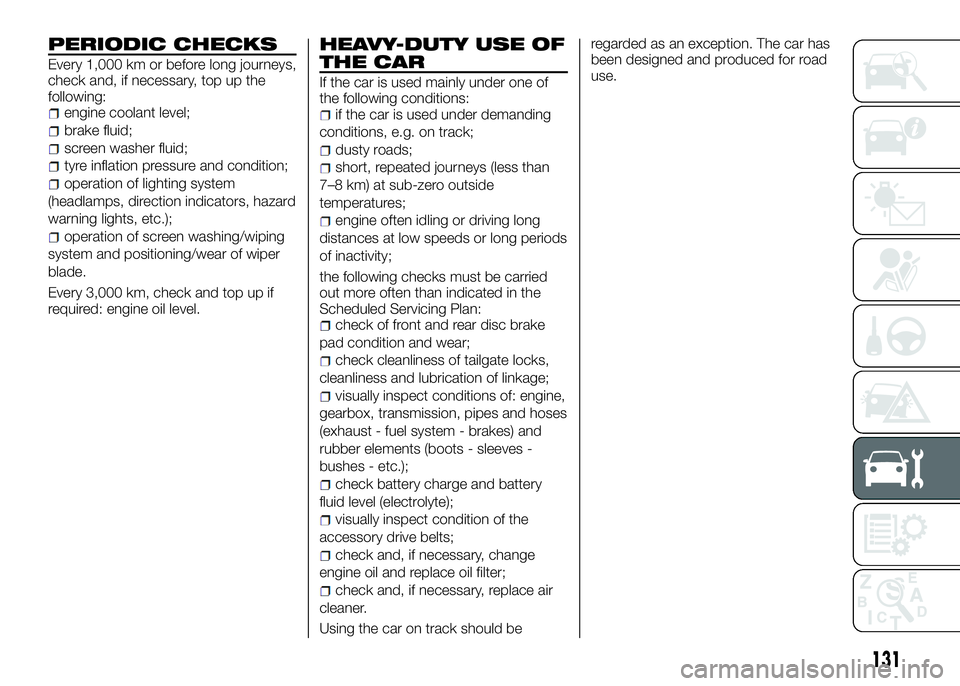
PERIODIC CHECKS
Every 1,000 km or before long journeys,
check and, if necessary, top up the
following:
engine coolant level;
brake fluid;
screen washer fluid;
tyre inflation pressure and condition;
operation of lighting system
(headlamps, direction indicators, hazard
warning lights, etc.);
operation of screen washing/wiping
system and positioning/wear of wiper
blade.
Every 3,000 km, check and top up if
required: engine oil level.
HEAVY-DUTY USE OF
THE CAR
If the car is used mainly under one of
the following conditions:
if the car is used under demanding
conditions, e.g. on track;
dusty roads;
short, repeated journeys (less than
7–8 km) at sub-zero outside
temperatures;
engine often idling or driving long
distances at low speeds or long periods
of inactivity;
the following checks must be carried
out more often than indicated in the
Scheduled Servicing Plan:
check of front and rear disc brake
pad condition and wear;
check cleanliness of tailgate locks,
cleanliness and lubrication of linkage;
visually inspect conditions of: engine,
gearbox, transmission, pipes and hoses
(exhaust - fuel system - brakes) and
rubber elements (boots - sleeves -
bushes - etc.);
check battery charge and battery
fluid level (electrolyte);
visually inspect condition of the
accessory drive belts;
check and, if necessary, change
engine oil and replace oil filter;
check and, if necessary, replace air
cleaner.
Using the car on track should beregarded as an exception. The car has
been designed and produced for road
use.
131
Page 141 of 182
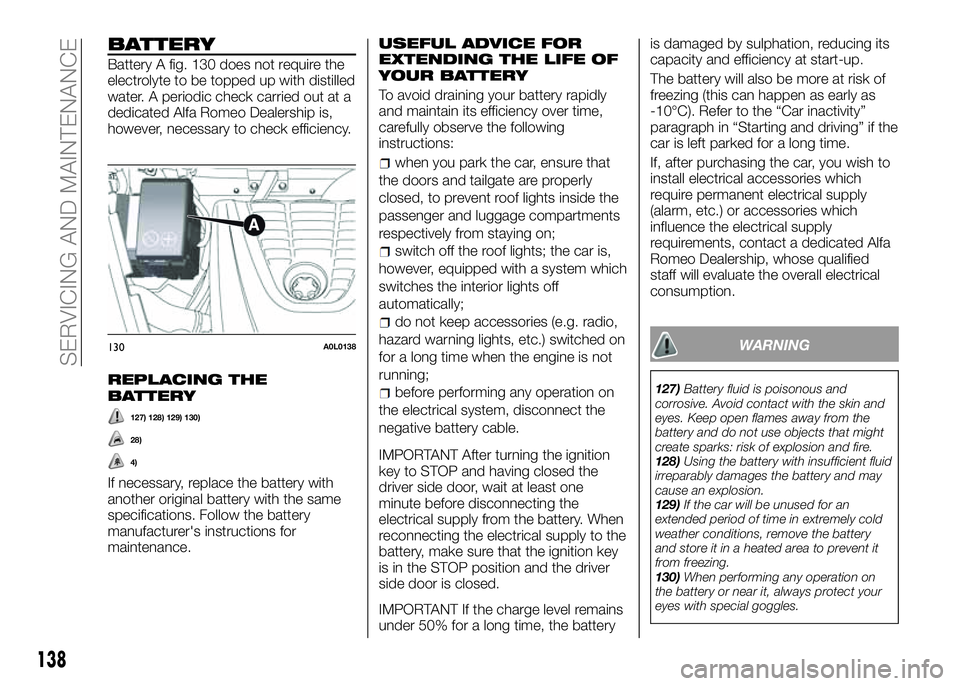
BATTERY
Battery A fig. 130 does not require the
electrolyte to be topped up with distilled
water. A periodic check carried out at a
dedicated Alfa Romeo Dealership is,
however, necessary to check efficiency.
REPLACING THE
BATTERY
127) 128) 129) 130)
28)
4)
If necessary, replace the battery with
another original battery with the same
specifications. Follow the battery
manufacturer's instructions for
maintenance.
USEFUL ADVICE FOR
EXTENDING THE LIFE OF
YOUR BATTERY
To avoid draining your battery rapidly
and maintain its efficiency over time,
carefully observe the following
instructions:
when you park the car, ensure that
the doors and tailgate are properly
closed, to prevent roof lights inside the
passenger and luggage compartments
respectively from staying on;
switch off the roof lights; the car is,
however, equipped with a system which
switches the interior lights off
automatically;
do not keep accessories (e.g. radio,
hazard warning lights, etc.) switched on
for a long time when the engine is not
running;
before performing any operation on
the electrical system, disconnect the
negative battery cable.
IMPORTANT After turning the ignition
key to STOP and having closed the
driver side door, wait at least one
minute before disconnecting the
electrical supply from the battery. When
reconnecting the electrical supply to the
battery, make sure that the ignition key
is in the STOP position and the driver
side door is closed.
IMPORTANT If the charge level remains
under 50% for a long time, the batteryis damaged by sulphation, reducing its
capacity and efficiency at start-up.
The battery will also be more at risk of
freezing (this can happen as early as
-10°C). Refer to the “Car inactivity”
paragraph in “Starting and driving” if the
car is left parked for a long time.
If, after purchasing the car, you wish to
install electrical accessories which
require permanent electrical supply
(alarm, etc.) or accessories which
influence the electrical supply
requirements, contact a dedicated Alfa
Romeo Dealership, whose qualified
staff will evaluate the overall electrical
consumption.
WARNING
127)Battery fluid is poisonous and
corrosive. Avoid contact with the skin and
eyes. Keep open flames away from the
battery and do not use objects that might
create sparks: risk of explosion and fire.
128)Using the battery with insufficient fluid
irreparably damages the battery and may
cause an explosion.
129)If the car will be unused for an
extended period of time in extremely cold
weather conditions, remove the battery
and store it in a heated area to prevent it
from freezing.
130)When performing any operation on
the battery or near it, always protect your
eyes with special goggles.
130A0L0138
138
SERVICING AND MAINTENANCE
Page 172 of 182
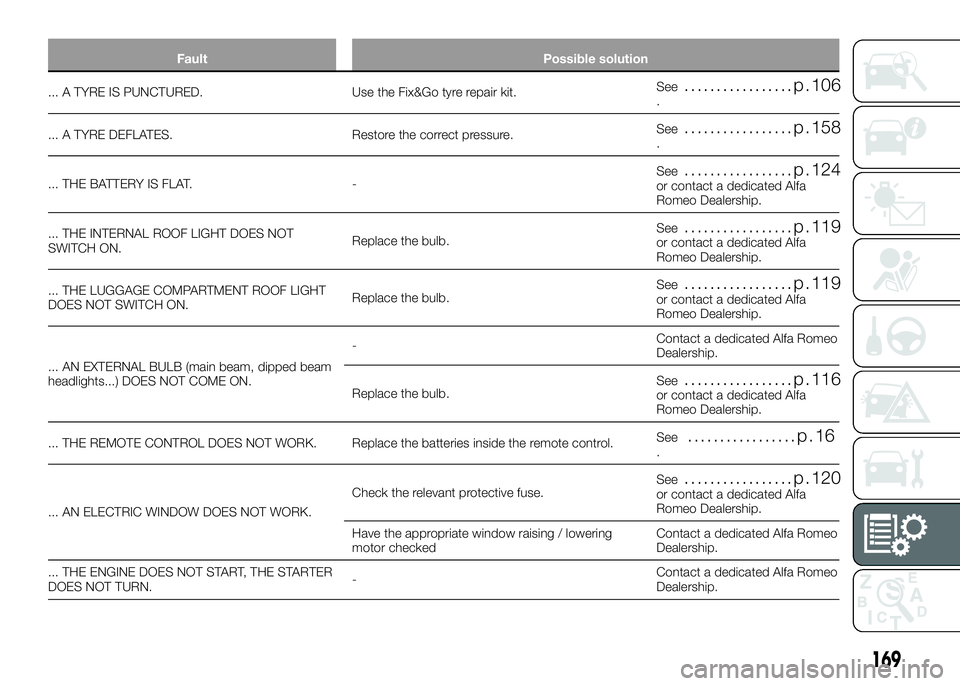
Fault Possible solution
... A TYRE IS PUNCTURED. Use the Fix&Go tyre repair kit.See.................p.106.
... A TYRE DEFLATES. Restore the correct pressure.See
.................p.158.
... THE BATTERY IS FLAT. -See
.................p.124or contact a dedicated Alfa
Romeo Dealership.
... THE INTERNAL ROOF LIGHT DOES NOT
SWITCH ON.Replace the bulb.See
.................p.119or contact a dedicated Alfa
Romeo Dealership.
... THE LUGGAGE COMPARTMENT ROOF LIGHT
DOES NOT SWITCH ON.Replace the bulb.See
.................p.119or contact a dedicated Alfa
Romeo Dealership.
... AN EXTERNAL BULB (main beam, dipped beam
headlights...) DOES NOT COME ON.-Contact a dedicated Alfa Romeo
Dealership.
Replace the bulb.See
.................p.116or contact a dedicated Alfa
Romeo Dealership.
... THE REMOTE CONTROL DOES NOT WORK. Replace the batteries inside the remote control.See
.................p.16.
... AN ELECTRIC WINDOW DOES NOT WORK.Check the relevant protective fuse.See
.................p.120or contact a dedicated Alfa
Romeo Dealership.
Have the appropriate window raising / lowering
motor checkedContact a dedicated Alfa Romeo
Dealership.
... THE ENGINE DOES NOT START, THE STARTER
DOES NOT TURN.-Contact a dedicated Alfa Romeo
Dealership.
169
Page 179 of 182
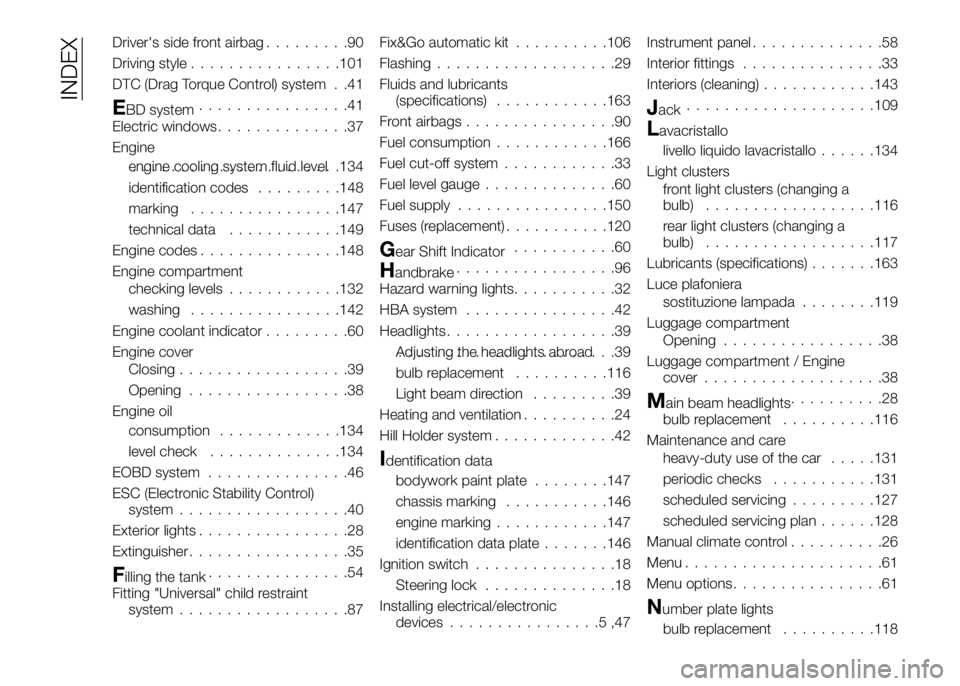
Driver's side front airbag.........90
Driving style................101
DTC (Drag Torque Control) system . .41
EBD system................41
Electric windows..............37
Engine
engine cooling system fluid level......................134
identification codes.........148
marking................147
technical data............149
Engine codes...............148
Engine compartment
checking levels............132
washing................142
Engine coolant indicator.........60
Engine cover
Closing..................39
Opening.................38
Engine oil
consumption.............134
level check..............134
EOBD system...............46
ESC (Electronic Stability Control)
system..................40
Exterior lights................28
Extinguisher.................35
Filling the tank...............54
Fitting "Universal" child restraint
system..................87Fix&Go automatic kit..........106
Flashing...................29
Fluids and lubricants
(specifications)............163
Front airbags................90
Fuel consumption............166
Fuel cut-off system............33
Fuel level gauge..............60
Fuel supply................150
Fuses (replacement)...........120
Gear Shift Indicator...........60
Handbrake.................96
Hazard warning lights...........32
HBA system................42
Headlights..................39
Adjusting the headlights abroad.......................39
bulb replacement..........116
Light beam direction.........39
Heating and ventilation..........24
Hill Holder system.............42
Identification data
bodywork paint plate........147
chassis marking...........146
engine marking............147
identification data plate.......146
Ignition switch...............18
Steering lock..............18
Installing electrical/electronic
devices................5,47Instrument panel..............58
Interior fittings...............33
Interiors (cleaning)............143
Jack....................109
Lavacristallo
livello liquido lavacristallo......134
Light clusters
front light clusters (changing a
bulb)..................116
rear light clusters (changing a
bulb)..................117
Lubricants (specifications).......163
Luce plafoniera
sostituzione lampada........119
Luggage compartment
Opening.................38
Luggage compartment / Engine
cover...................38
Main beam headlights..........28
bulb replacement..........116
Maintenance and care
heavy-duty use of the car.....131
periodic checks...........131
scheduled servicing.........127
scheduled servicing plan......128
Manual climate control..........26
Menu.....................61
Menu options................61
Number plate lights
bulb replacement..........118
INDEX